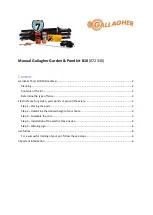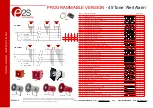
Section 2: Operating Procedures
SA10 Hydraulic Post Hole Digger 317-433M
6/2/22
19
Sideshift Cradle Left or Right
Figure 2-3
Sideshift Cradle
Refer to Figure 2-3:
WARNING
!
To prevent serious injury or death:
The cradle sliding on rails creates a pinch point hazard. Stay
clear of horizontal rails and other nearby obstructions while
1. After having unhooked motor and hoses, restart
tractor and backup in a straight line for approximately
24" (61 cm).
2. Rotate hitch plate vertical or slightly pass vertical.
3. Shut tractor down according to
4. Loosen nuts (#1 & #2) until all tension is released.
Do not remove the nuts.
5. Slide cradle (#3) left or right on horizontal rails (#4) to
the desired location.
6. Tighten 1/2"-13 nuts (#1 & #2) to the correct torque
for a GR5 bolt.
Hook-up Motor and Hoses
Refer to Figure 2-2 on page 18:
DANGER
!
To prevent serious injury or death:
A crushing hazard exists around power equipment. Do not
allow anyone near the attachment and/or power machine
while operating hydraulic controls and when approaching or
backing away from the attachment.
1. Restart tractor and rotate hitch plate (#9) horizontal
as before and adjust tractor to realign clevis (#7) with
pivot link (#5).
78333
Left
Right
IMPORTANT:
Hose routing is the responsibility of
the owner/operator. Pinched and/or stretched hoses
are not covered under the warranty.
IMPORTANT:
Make sure coupler fittings on the
hydraulic hoses and power machine are clean
before connecting them together.
2. Stop tractor close to pivot link (#5), shut tractor down
according to
.
3. Manually slide pivot link (#5) into clevis (#7) until
holes in the clevis and pivot link align with each other.
4. Attach pivot link (#5) to clevis (#7) with clevis pin (#1)
and washer (#6). Secure pin with hairpin cotter (#2).
5. Attach hydraulic hoses (#9) to the loader couplers.
Transport With Post Hole Digger
WARNING
!
To avoid serious injury or death:
•
Transport with the tilt cylinder fully retracted, motor
assembly supported in the cradle, and auger lowered to a
height that does not block the operator’s view.
•
Cross ditches and enter inclines slowly and carefully. The
auger can come in contact with the ground causing damage
to the equipment and operator to lose control.
•
Always travel straight up and straight down inclines. Never
•
Slow down when traveling over rough or hilly terrain that
can cause equipment to bounce, or to hit obstacles that are
close by. Either situation can cause damage and/or the
•
Keep attachment, loader arms, and/or load away from
overhead electrical power lines. Place an orange warning
sign under overhead lines indicating type of danger above.
•
When traveling on public roadways, travel in such a way
that faster moving vehicles may pass safely. Use accessory
lights, clean reflectors, and a slow moving vehicle sign that
is visible from the back to warn operators in other vehicles
of your presence. Always comply with all federal, state, and
1. Select a safe ground travel speed when transporting
from one area to another.
2. Transport with the tilt cylinder fully retracted, motor
assembly supported in the cradle, and auger low to
the ground at a height that does not block your view.
3. Always travel straight up and straight down inclines.
Make turns only on level ground.
4. Enter ditches and inclines slowly to make sure the
auger does not dig into the ground. If needed, stop
and raise auger to cross ditches and enter inclines.
5. Reduce transport speed when traveling over rough
or hilly terrain.
6. Reduce tractor ground speed when turning. Leave
enough room to clear obstacles such as buildings,
trees, and fences.
7.
Keep away from electrical power lines. Place an
orange warning sign under overhead power lines
indicating type of danger above.
8. When traveling on roadways, transport in such a way
that faster moving vehicles may pass you safely.
















































